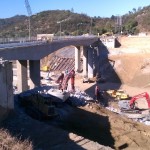 Last year I looked at a project that was part of the Engineering Grand Challenges that aimed to move cities towards more of a ‘self-repairing’ state, whereby robots can both detect and then repair various faults in our urban infrastructure.
Last year I looked at a project that was part of the Engineering Grand Challenges that aimed to move cities towards more of a ‘self-repairing’ state, whereby robots can both detect and then repair various faults in our urban infrastructure.
The robots will initially be developed in three core areas:
- Drones that can perch on high strctures and perform various repair tasks, such as fixing street lights.
- Pothole drones that can autonomously inspect the road surface, diagnose potholes, and then patch up the road, whilst also helping to prevent further deterioration.
- Utility robots that live permanently inside utility pipes, performing a continuous monitoring and repair service. Such robots could also report status and even perform metering tasks.
Suffice to say, this kind of world is still a little way off, and there is a lot that can be done to improve our cities before such a future materializes.
The McKinsey Global Institute estimate that the world needs $57 trillion of infrastructure investment by 2030, so it stands to reason that investment on that scale needs to be coordinated.
Optimizing urban repair
A recent paper outlines how repairs and maintenance works can be coordinated and managed so that they are completed in an efficient manner.
The paper outlines a better way of tracking the various works that are going on, and any issues associated with the repair of road, water and sewer networks.
“The main problem is that city infrastructure planners often work in silos,” the authors say. “When the infrastructure shares the same space, the integration of roads, water and waste water is a major planning challenge.”
The software aims to combine the various variables of road, water and sewage networks to overcome the silos that shackle infrastructure works.
It also identifies a number of possible risk factors and consequences should the project fail, whilst alerting staff to areas of particular concern and the best way to allocate resources.
Infrastructure across the developed world is at something of a breaking point, with governments largely failing to give their networks the funding required to keep them in good working order.
With over $400 billion a year spent by the US government on infrastructure per year, any efficiency savings that can be made could be hugely beneficial and help avoid the dreadful scenes we’ve seen in Flint recently.
“Forty-two per cent of America’s major urban highways are congested, and three-quarters of waste-water systems need pipe repair. It’s not much better in Canada, where about 30 per cent of municipal infrastructure has been assessed as between fair and very poor,” the authors warn.
The software has already been tested out in a pilot project in the City of Guelph, and the aim is to now roll it out in municipalities around the world.
“These problems are common in cities around the world,” the team say. “By using this software, we remove the planning issues that often exist between these separate entities and consider a city’s infrastructure issues more holistically.
“The end result is a more streamlined repair and rehabilitation process that uses the available budget in the most efficient way possible.”
To be honest with you, I'd be happy if they could just repair the roads without a utility company coming along a week later and digging them up again! Simple things, y'know?